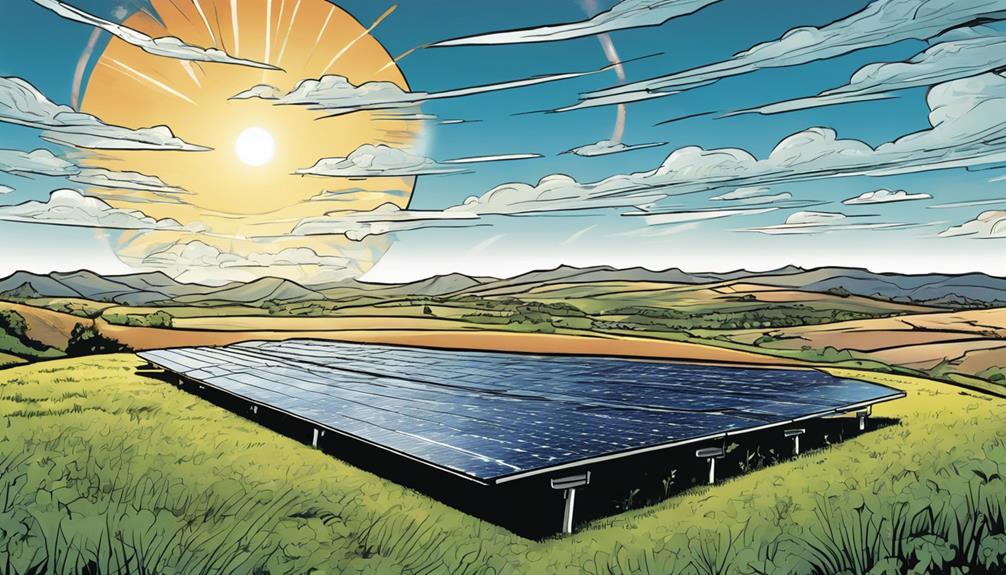You capture solar energy by harnessing the sun's radiation through photovoltaic cells in solar panels, which convert sunlight into electrical current. These cells trigger an electric current through the photovoltaic effect, generating clean, renewable energy. Alternatively, thermal energy harvesting methods absorb and store heat for later use, efficiently capturing the sun's radiation. As you explore the world of solar energy, you'll discover the ins and outs of systems integration and storage, soft costs, and industry trends – and reveal the full potential of harnessing the sun's power for a sustainable future.
Key Takeaways
- Solar panels convert sunlight into usable energy through photovoltaic cells, generating electrical current via the photovoltaic effect.
- Black bodies absorb thermal energy efficiently, allowing for effective solar energy absorption and heat generation.
- Vacuum tube solar water heaters transfer solar energy effectively, providing a reliable method for harnessing thermal energy.
- Solar panels hold multiple photovoltaic cells together, enabling the efficient capture of solar radiation and electricity generation.
- Inverters convert DC electricity from solar panels to AC, making it compatible with the grid and enabling efficient energy distribution.
Harnessing Solar Radiation
You can tap into the sun's energy by harnessing solar radiation, a crucial step in capturing solar energy. This process involves using solar panels to convert sunlight into a usable form of energy.
When sunlight hits the photovoltaic cells in these panels, it excites the electrons, generating an electrical current. This current can then be harnessed to power your home, business, or even entire communities.
By harnessing solar radiation, you're not only reducing your reliance on fossil fuels but also decreasing your carbon footprint. The amount of energy you can generate depends on the intensity of the sunlight and the efficiency of your solar panels.
However, with advancements in technology, it's becoming increasingly possible to capture a significant portion of the sun's energy. By doing so, you'll be contributing to a cleaner, more sustainable future.
Photovoltaic Energy Conversion
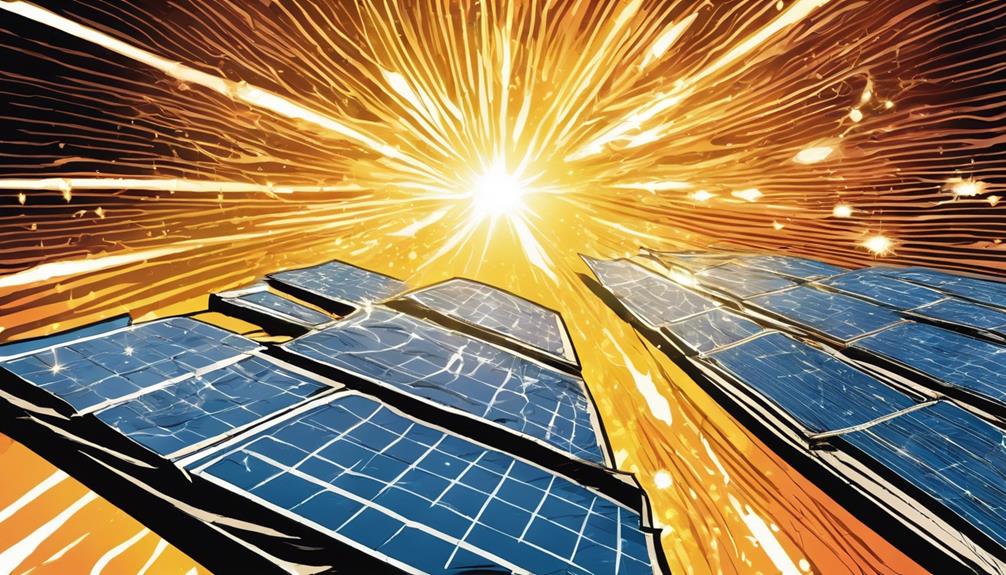
As you explore photovoltaic energy conversion, you'll discover that PV cells play an essential role in generating electricity from sunlight.
These cells, made of semiconductor materials, are designed to convert sunlight into an electrical charge.
Now, let's take a closer look at how PV cells function and how they produce an electrical charge.
PV Cell Functionality
As you explore the world of solar energy, understanding how PV cells work is vital. PV cells within solar panels trigger an electric current when sunlight excites their semiconductor materials, releasing electrons that flow through an electrical circuit. This phenomenon is known as the photovoltaic effect. When you think about it, it's amazing that sunlight can be converted into electricity through a single solar cell.
Here's a breakdown of how PV cells function:
| Component | Role |
|---|---|
| Semiconductor material | Converts sunlight into electricity |
| Electrons | Flow through the electrical circuit |
| Electrical circuit | Carries the electric current generated |
| Solar panel | Holds multiple PV cells together |
You're probably wondering how this technology works on a larger scale. The truth is, photovoltaic technology has come a long way in producing clean, renewable energy from sunlight. When you combine multiple solar cells, you get a solar panel, and when you connect multiple panels, you get a solar array. This array can power homes, businesses, and even entire communities. The possibilities are endless, and it all starts with the humble PV cell.
Electrical Charge Generation
During the photovoltaic effect, sunlight absorption in PV cells triggers the release of electrons, generating electrical charges that flow through an electrical circuit. As you explore how solar energy is captured, you'll discover that these photovoltaic cells are the core of the process. When sunlight hits them, electrons are released, creating a flow of electricity.
The electrical charges produced by PV cells are harnessed to generate direct current (DC) electricity. But that's not the end of the process. Inverters are used to convert the DC electricity from PV cells into usable alternating current (AC) electricity, making it suitable for various applications.
You're likely curious about how this technology works. The good news is that photovoltaic technology is a vital method for converting solar radiation into electricity. By generating electrical charges through the photovoltaic effect, PV cells play an essential role in harnessing the power of the sun.
As you explore further into the world of solar energy, you'll realize that this technology has the potential to revolutionize the way we generate power. With the ability to generate clean, renewable energy, photovoltaic cells are a fundamental component of our sustainable future.
Thermal Energy Harvesting Methods

As you explore thermal energy harvesting methods, you'll discover how they efficiently capture the sun's radiation to generate heat.
You'll learn about the importance of effective solar energy absorption, thermal energy storage, and heat transfer systems in these processes.
Solar Energy Absorption
How do you capture the sun's energy to generate heat, an essential step in harnessing solar power? Solar energy absorption is the key to accessing thermal energy harvesting methods. Through solar energy absorption, you can capture and convert the sun's radiation into heat, paving the way for renewable energy generation.
Here are some ways to absorb solar energy:
- Black bodies: These absorb thermal electromagnetic energy from the sun, allowing for efficient heat generation.
- Solar water heaters: These circulate cool water through panels to heat it using solar energy, providing a reliable source of hot water.
- Vacuum tube solar water heaters: These utilize heat pipes to transfer solar energy efficiently, making them a popular choice for solar water heating.
Thermal Energy Storage
By harnessing thermal energy storage, you can access the sun's power even when it's not shining, ensuring a steady supply of energy throughout the day. This innovative technology allows you to collect excess solar heat during peak sunlight hours, storing it for later use when the sun dips below the horizon.
The heat is absorbed by materials like molten salt or rocks, which can retain it for hours or even days.
Thermal energy storage systems are essential for maximizing the efficiency and effectiveness of solar power generation. By storing heat during the day, you can generate electricity when it's needed most, even after sunset. This means you can enjoy a reliable source of energy, 24/7, without interruptions.
With thermal energy storage, you can overcome the intermittency of solar energy, providing a stable and consistent power supply. By leveraging this technology, you can access the full potential of solar energy, making it a more viable and attractive option for powering your home or business.
Heat Transfer Systems
You can harness the sun's energy through heat transfer systems, which capture solar radiation and convert it into usable heat using materials like black bodies. These systems are a key part of thermal energy harvesting, allowing you to tap into the sun's power for various applications.
Here are some examples of heat transfer systems in action:
- Solar water heaters: These systems use heat transfer to warm up water for residential use. Vacuum tube solar water heaters, in particular, are known for their efficient heat transfer methods, making them a popular choice.
- Molten salt solar power: This system employs molten salt to store and transfer solar energy, which is then used to generate electricity. The high-temperature heat transfer fluid allows for efficient energy storage and generation.
- Thermal energy storage: Heat transfer systems can also be used to store thermal energy for later use, such as in molten salt systems. This allows you to harness solar energy during the day and use it at night or during periods of low sunlight.
Systems Integration and Storage
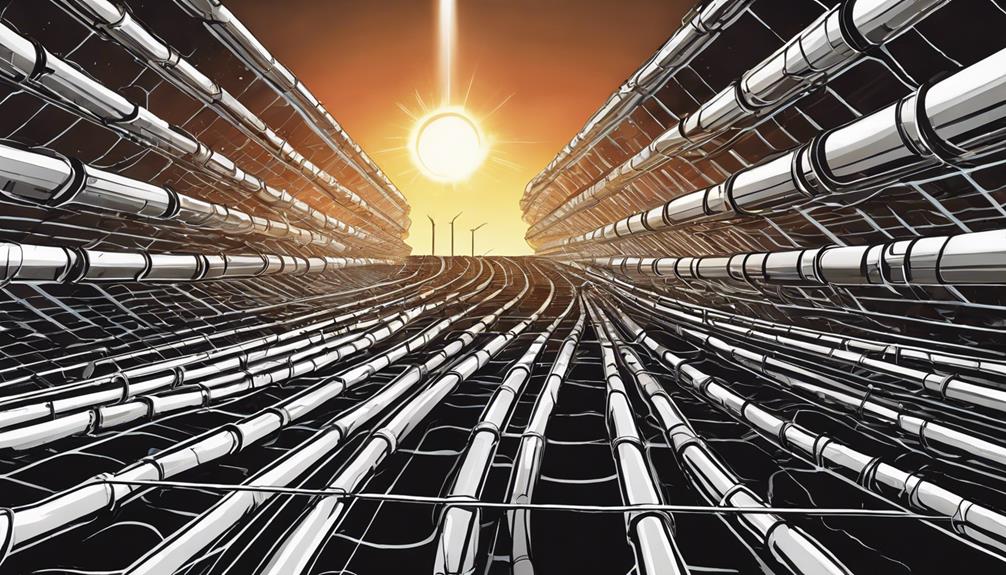
As you plug into the grid, integrating solar energy systems into homes, businesses, and electrical grids becomes necessary for maximizing efficiency and benefits. This systems integration is essential for harnessing the full potential of solar energy.
Inverters play a key role in this process, converting DC electricity from solar panels to AC electricity that's compatible with the grid. However, solar energy storage is also vital for maintaining grid stability and reliability, especially during periods of low sunlight.
By integrating solar energy with other renewable sources like wind power, you can create a more sustainable energy mix. Efficient systems integration and storage solutions are crucial for tapping into the full potential of solar energy in powering our communities.
As you explore ways to capture solar energy, remember that renewable energy integration is key to a cleaner, greener future. By prioritizing efficiency in solar energy, you can make a significant impact on reducing our reliance on fossil fuels and mitigating climate change.
Soft Costs and Industry Trends

Solar energy's affordability is impeded by soft costs, which can make up a staggering 64% of total system costs, making it essential to tackle these expenses to bring down the overall price of solar installations. As you delve into the solar industry, you'll find that soft costs are a significant barrier to widespread adoption.
Here are some key areas that contribute to these high costs:
- Customer acquisition costs, which can be substantial, are a major component of soft costs.
- Permitting processes, often slow and bureaucratic, drive up financing expenses and add to the overall cost of solar installations.
- Workforce development initiatives aim to address labor shortages and skill gaps, which can also contribute to higher soft costs.
To overcome these challenges, industry leaders are focusing on technology innovations and business model changes to reduce soft costs. By streamlining permitting processes, improving customer acquisition strategies, and investing in workforce development, the solar industry can become more sustainable and accessible to consumers.
As you continue to explore the world of solar energy, you'll see how these efforts are essential to making solar power a more viable option for everyone.
Going Solar: Benefits and Challenges
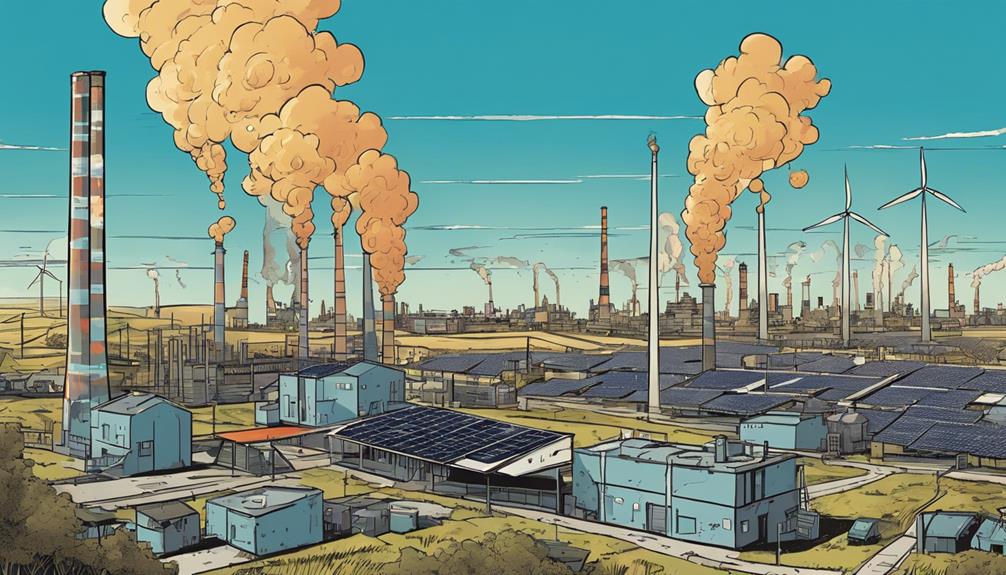
Shifting to solar energy can significantly decrease your dependence on the grid, slashing electricity expenses by up to 100% and offering backup power during outages. This not just helps you save money but also strengthens grid resilience. However, embracing solar energy comes with its own set of obstacles. Indirect expenses, such as permitting and financing, can affect the feasibility of solar energy adoption.
| Advantages | Obstacles |
|---|---|
| Lowers electricity bills by up to 100% | Indirect costs (permitting, financing) |
| Supplies backup power during outages | Incorporating with existing grids necessitates storage solutions |
| Improves grid resilience | |
| Generates employment opportunities and contributes to economic growth |
In spite of these obstacles, the merits of transitioning to solar energy surpass the downsides. While contemplating the shift to solar energy, it's crucial to evaluate these factors and investigate available incentives to make the switch more economical. By doing so, you will not just decrease your electricity expenses but also play a role in fostering a more sustainable future.
Solar Energy Technologies Explained
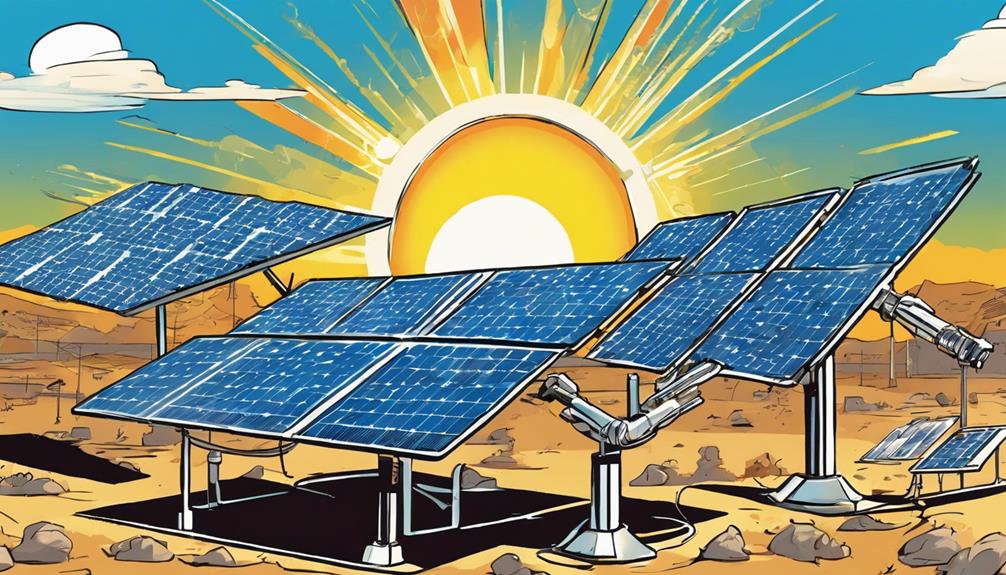
You're about to immerse yourself in a world of innovative solutions, where sunlight is harnessed in various ways to generate electricity, heat water, and store energy for later use. As you explore the domain of solar energy technologies, you'll discover a range of cutting-edge solutions that are transforming the way we capture and utilize sunlight.
Some of the most promising solar technologies include:
- Photovoltaic (PV) solar panels: These convert sunlight directly into electricity using semiconductor materials.
- Concentrating Solar Power (CSP) systems: These concentrate sunlight using mirrors or lenses to produce heat for electricity generation.
- Solar water heaters: These utilize thermal energy from the sun to heat water for residential or commercial use, with vacuum tube solar water heaters being particularly efficient.
From molten salt solar power systems that store solar energy for later conversion into electricity to advanced semiconductor materials that enhance energy conversion, the possibilities are endless.
As you explore deeper into the world of solar energy technologies, you'll find yourself at the forefront of a revolution that's changing the way we think about energy production and consumption.
Environmental Impact and Mitigation
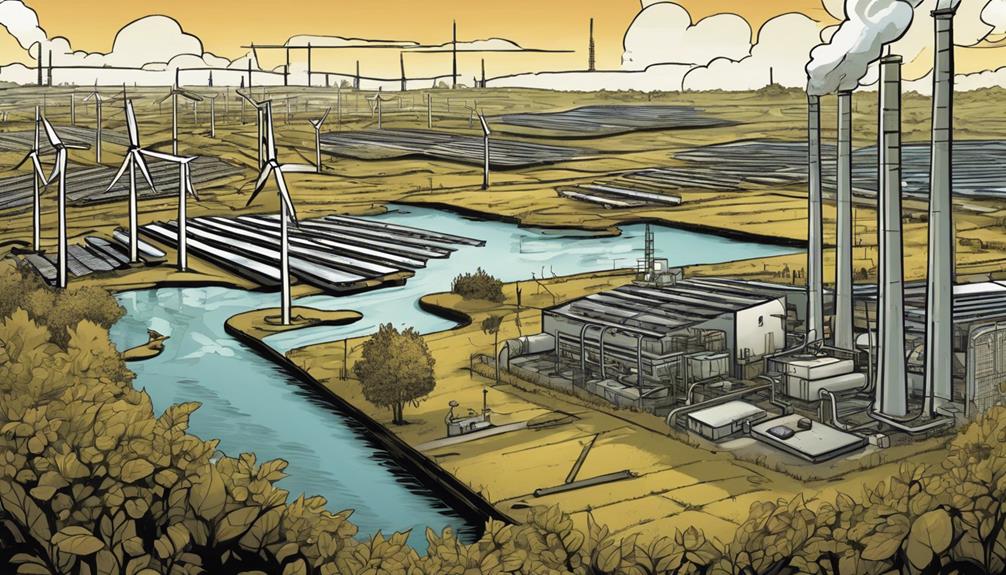
As you explore the benefits of harnessing sunlight, it's evident that the environmental advantages of solar energy are just as impressive as the technologies themselves.
One of the most noteworthy benefits is the reduced environmental impact. By switching to solar energy, you'll markedly decrease greenhouse gas emissions, contributing to a cleaner environment and combating climate change.
Additionally, implementing solar energy systems can alleviate the urban heat island effect in cities, making them cooler and more livable. The long lifespan of solar panels, exceeding 25 years, ensures sustainability and environmental impact mitigation.
As you adopt solar energy, you'll not only reduce your reliance on fossil fuels but also enjoy long-term benefits like reduced taxes and eliminated electricity bills. With solar energy, you're taking a notable step towards a more sustainable future. By choosing solar, you're choosing a cleaner, greener tomorrow.
The Future of Solar Energy Systems

Solar energy systems are on the cusp of a revolution, driven by rapid advancements in technology and design that promise more efficient, sustainable, and connected systems. As you look to the future of solar power, you can expect to see significant improvements in energy generation.
Here are a few exciting developments on the horizon:
- Next-gen photovoltaic (PV) panels: Innovations like perovskite solar cells and bifacial panels are shaping the next generation of solar systems, promising higher efficiency rates and lower costs.
- Grid-scale solar projects: Large-scale solar projects are becoming increasingly common, enabling the integration of solar energy into the grid and expanding access to clean energy.
- Smart energy management: Emerging technologies like IoT and AI are being integrated into solar energy systems, enhancing performance, efficiency, and connectivity.
These advancements won't only increase the adoption of solar power but also improve its overall performance. As you consider the future of solar energy systems, it's clear that the possibilities are vast and promising.
With continued innovation and investment, solar energy is poised to play an increasingly important role in our shift to a more sustainable energy future.
Frequently Asked Questions
How to Capture Solar Energy?
You're wondering how to capture solar energy? Well, you can do it through photovoltaic panels, concentrating solar power systems, solar water heaters, vacuum tube heaters, or molten salt systems, each harnessing the sun's power in unique ways. All of these technologies have their own strengths and applications, but they all share the same goal of leveraging solar energy benefits. By using these systems, we can reduce our reliance on fossil fuels, decrease harmful emissions, and ultimately contribute to a cleaner and more sustainable energy future. Additionally, harnessing solar energy can lead to cost savings for individuals and businesses, making it a practical and environmentally-friendly choice for energy production.
What Process Captures Solar Energy?
You're wondering what process captures solar energy? Well, it's through various methods like photovoltaic effect, concentrated sunlight, thermal energy absorption, or molten salt storage, which convert sunlight into electricity or heat for practical uses.
How Do We Capture Solar Energy in Space?
You capture solar energy in space by deploying solar panels in orbit, where they can receive constant sunlight without atmospheric interference, and then transmit the energy back to Earth via microwave or laser beams.
How Do We Harvest Solar Energy?
You harvest solar energy through various methods, including photovoltaic panels that convert sunlight into electricity, thermal energy harvesting for heat applications, and solar water heaters that warm water for daily use.
Conclusion
As you stand amidst a sea of solar panels, the warm sunbeams dancing across your face, you're reminded of the incredible power harnessed from above.
The hum of energy conversion, the gentle hiss of thermal systems, and the soft glow of stored power all blend into a symphony of innovation.
You're part of a movement that's rewriting the future, where the sun's fiery passion fuels a cleaner, brighter tomorrow.
The journey's just beginning, and the possibilities are endless – shine on!
